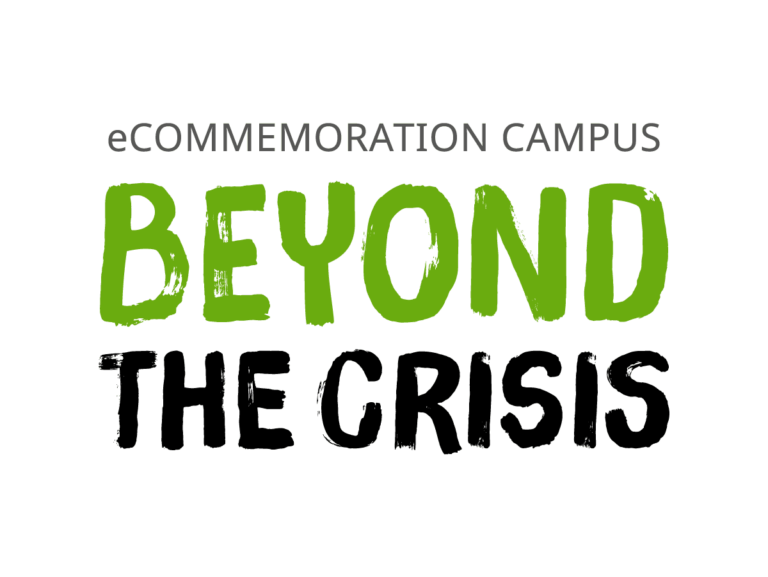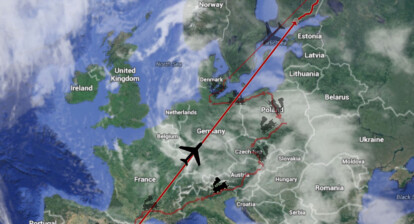Motivation
The motivation of the project is to investigate the impact Covid-19 had on the world, especially on society, asking how the participants are experiencing the situation, asking variable and simple questions. And what I am going to do, is explain what I have learned from the responses of the participants.
What is the Coronavirus?
The coronavirus or Covid-19, Coronavirus SARS-CoV-2 is a respiratory infectious disease that can spread from person to person. The virus was first identified during the investigation of an outbreak in Wuhan, China. Currently Covid-19 has affected a pandemic that has damaged many countries around the world.
What are the symptoms of Covid-19?
The most common symptoms of Covid-19 are fever, nasal congestion, respiratory distress, headache and a sore throat.
Older people are at higher risk because:
- They have health problems such as high blood pressure
- Heart and lung problems
- Diabetes, Obesity
- Cancer
- Smoking.
Results questionnaire:
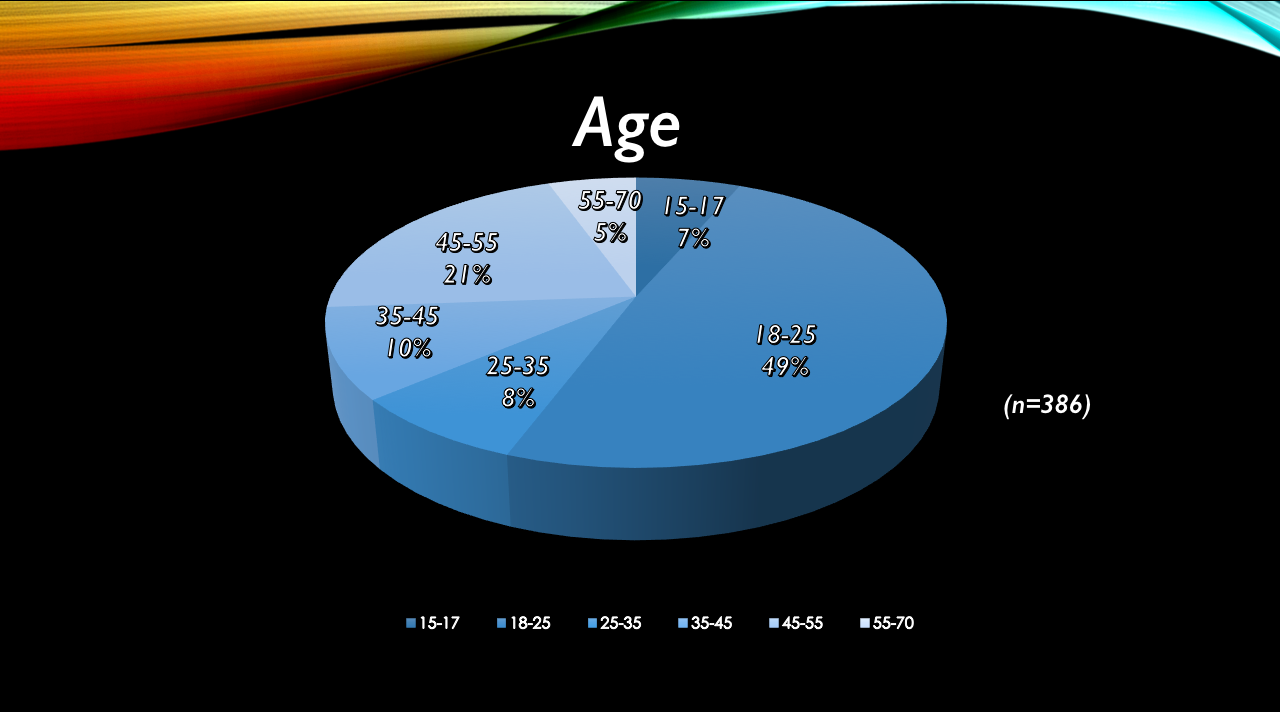
Age of the questionnaire participants. N = 386.

Gender relation in the survey.
Large range of age from 15 to 70 years. What I have acquired in the survey:
- The majority of participants are young people, ages from 15 to 30 with a percentage of 56%
- Adults from ages 30 to 70 with a percentage of 44%.

Contry of origin of participants.
Continents participate
- Europe 58,2%
- America (USA, Argentine,Mexico) 41,2%
- Oceania (New Zeland) 0,51%
Emotional:
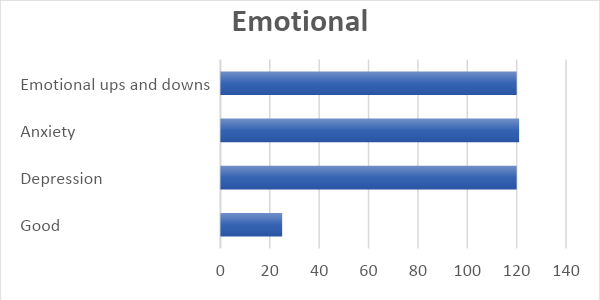
Emotions triggered through Covid-19.
The results:
- Depression 31,08%
- Emotional ups and downs 31,00% (Variable Emotional State)
- Anxiety 31,34%
- Good 6.58%.
We asked the participants how the coexistence situation was that they went through in the confinement. I acquired the results of the participants: The majority voted that they passed the confinement with families with a percentage of 2.55%, couples with 0.45% or alone with 0.41%. Then other participants voted that they were accompanied by a pet with 0.1%, a shared apartment with 0.25% or a residence with 0.1%.
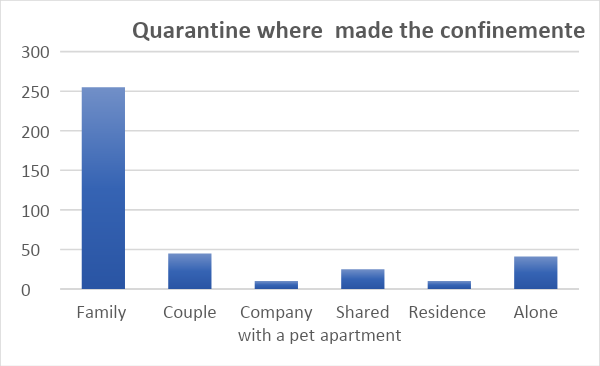
How the participants lived through the lockdown.
- Relationship Family or Partner 75,12 %
- Shared Center 9,00%
- Alone 10,62%
- Accompanied by Animal 5,8%
Health:

How many of the participants were tested positive and negative for the Covid-19 virus.

Where did people get infected with the virus.
Persons diagnosed with Covid-19 and had to do quarentine. How did they react?

How people reacted to their infection.
How did people react to their infection?

How the pandemic impacted people economically.
The questioned person feelt worried and scared, 80,24% stating this fact. It is big trouble for the people.
Where do people work – who were still working – during the pandemic
People surveyed, lost the work at the start of the pandemia: 52% (n=201 persons)

Where did people work during the pandemic.

How did the pandemic affect the quality of education?
From which places do they carry out the training and education processes?

From which places do they carry out the training and education processes?
Conclusion of the Effects of the Pandemic
- The age of participation, the age group of 15 to 30 years was 56%.
- Gender and Sex: 55% were women.
- Location and place of participation: Europe and the American continent were the ones with the highest participation.
- The effect of the Pandemic on the Emotional State, presented more than 62% of alterations in mental health, reflected in acute pictures of anxiety or depression.
- The people who are accompanied in the format of families, couples are the vast majority (more than 75%), which indicates that being accompanied and collaborating is an instinct for survival, in these times and helps our society.
- In a number 42% of the people surveyed, they were tested through the PCR test, they were COVID Positive + (n = 162). of the 386 people who participated in the survey.
- Of the people who were diagnosed with COVID (n = 162), when more than 80% of these were diagnosed, they had feelings of fear and concern for their lives.
- The Impact of the Pandemic on the Economy, reflects that 52% of those surveyed lost their usual jobs, and more than 30% of the people lost the ability to save and consume daily money.
- Also the telework format grew by more than 50%, being a growing trend, with respect to the classic and face-to-face work format.
- These 2 variables clearly show us that the pandemic negatively affected the population economy studied, and that it will have a great challenge in adapting to new work formats linked to technologies.
- The Impact of the Pandemic on Education, the quality and education systems were taken into account.
- Assessing that more than 60% of the respondents suggest a loss in the quality of the education provided.
- And that there is an increase of more than 55% of the telematics education format, over 40% of the traditional education format.
Conclusion and Proposal
The changes so marked in this year 2020 invite to reflection and assessment of how the basic principles and values, such as good education, respect for institutions such as the Family and good management of people’s emotions, could be a matter to invest in our future, to be used as tools for developing solutions, only human gestures that help humans can bring us closer to resuming a path of hope and a fairer future for all.

